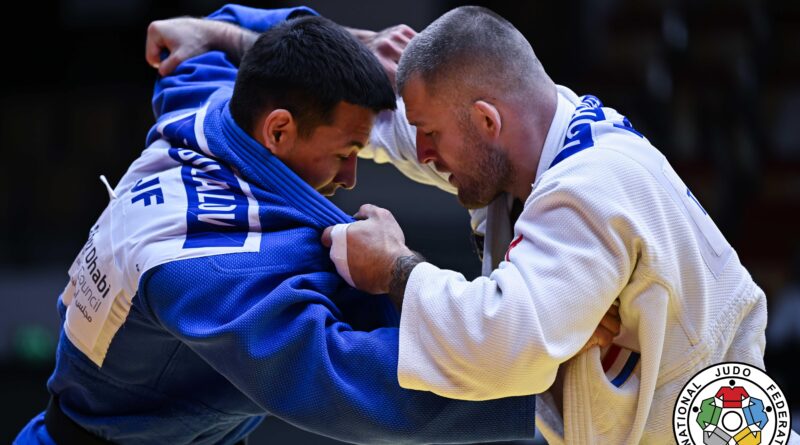Using data for successful benchmarking in judo

In elite sports, clarity about your starting point and goal is crucial for shaping your plan. Whether you are a judoka, coach, or another type of expert, you constantly ask yourself: where are we now, where do we want to go, and what do we need to do to get there? These questions are not easily answered. Especially in a sport like judo, which has a huge variety of techniques, tactics, mental processes, and physical factors.
A few weeks ago, I spoke with a coach. He told me: “I see my athlete working very hard, getting physically stronger and technically better, but I still wonder: are we really making the right choices? How do I know we’re on the right path and that our training is effective?” This uncertainty and questioning about what truly works is very common in the judo world.
Benchmarking helps us unravel this complex puzzle. A benchmark is a clearly defined starting point or endpoint: a personal, concrete image of what it takes to be where you ultimately want to be. It provides structure for the process of setting goals, training, and evaluating.
Despite its importance, I often hear objections from coaches and athletes about using data to form a benchmark. People frequently say: “Judo is too complex to measure objectively. Data analysis doesn’t tell me much; my experience and intuition give me more clarity.” I understand this attitude and I think it’s important to be critical. But that doesn’t mean data can’t add value.
Some say, for example: “Data doesn’t capture what happens on the mat; technique, tactics, and mentality aren’t measurable.” That’s true—those deeper layers of judo are difficult to quantify. But by combining data appropriately with your experience and coaching conversations, a much more complete and accurate picture emerges. This way, you don’t lose nuance but add a factual basis. At the same time, I want to stress that intuition and experience should never be excluded. The goal is to examine the picture from as many perspectives as possible to make it as complete as you can.
Solution-oriented coaching
Benchmarking starts by formulating a personal vision of your ideal performance, answering questions like:
- What does your perfect match look like?
- At what moments do you feel strong, in control, and know beforehand that you will be successful?
- What would your coaches and opponents notice about you when you’re at your best?
- What feelings and thoughts come with that?
Together, by exploring these future images on factual, emotional, and visual levels, you create a detailed picture. This makes your end goal personal and motivating. Using “what if” questions helps activate imagination: “What if you were technically at your best—how would that feel? How would you see it in the final, at the moment it counts?”
Using this questioning technique shifts your focus away from problems toward solutions and opportunities. It builds a positive mindset and makes it easier to shape your development intentionally.
Summary
- Benchmarking is not just measuring but also imagining. It’s about viewing things from multiple angles.
- Solution-oriented coaching activates the athlete’s vision for the future.
- Focusing on the future helps set a motivating and concrete goal that is tangible for the athlete.
The role of data in benchmarking
Judo is a dynamic sport with countless perspectives. This makes it challenging to directly translate subjective feeling and experience into measurable terms. That’s where data analysis of match factors comes into play.
Platforms like Judodata use advanced technologies to analyze competition videos and thus collect data. Movement patterns, attack attempts, scores, and counter-scores are recorded. Since this is done for all IJF World Tour matches throughout the season, the data is representative and reliable. The analyses are continually updated to reflect new rules and developments in the sport, keeping the data current and relevant.
Judodata accurately records:
- How often an athlete attacks in standing (tachi-waza) or ground techniques (ne-waza).
- How often an athlete scores in standing.
- How often an athlete scores in ne-waza.
- How many scores they receive against them in both standing and ground phases.
This data is updated after each major tournament and thus reflects the current international level. Yes, the example data we use might be from before the latest rule changes, but the principle and method remain unchanged and easy to update with changes in the sport.
What can you concretely do with this data?
The values mentioned above can already tell you a lot about how you compare to, for example, a group of athletes who have performed well or were able to perform at a certain level—your benchmark group. This is the group you compare yourself to, to see where you stand now and where you can improve.
To get easily comparable figures, we calculate the following based on available numbers (from video analysis):
- Expected tachi-waza scores per match: how often are you expected to score standing per match, based on your historical data?
- Expected ne-waza scores per match: how often are you expected to score on the ground?
- Expected points against you in tachi-waza: how often are opponents expected to score against you standing per match?
- Expected points against you on the ground: how often are opponents expected to score against you in ne-waza?
By looking at the difference between your scores made and scores received (the ‘Adjusted Total Score’, ATS), you know whether you are more successful overall than your opponent. This number can be compared with the top athletes in your weight class and gives you an overview of your performance. It appears that among top performers in judo, a higher ATS correlates with higher performance. In other words, how much you score (whether standing or ground) and how little you concede determines your success in judo.
You might think: “Yes, that seems obvious.” However, the next articles will give you an idea of how this data can help determine where you need to develop to reach your highest level.
From numbers to development
Imagine you find out your average standing scores per match are lower than those of top judokas, while your ground scores are similar. What does that mean?
It might mean you make too few attacks in standing fights. Then your attack ratio is low, and you need to work on initiating action more often. Another possibility is your attacks aren’t efficient enough: you attack enough, but your techniques lead to too few points. This requires technical training and focus on converting opportunities into actual scores. When your average scores per match are low, it might be due to efficiency or attack ratio — and the data can show you this. Identifying your areas for improvement on these fronts is crucial for setting your development goals.
If you score a lot but also concede a lot, it may hurt your final result. A positive scoring balance is very important for success, looking at the international benchmarks. In these cases, focus could also be on defensive ability: improving grip fighting (kumi-kata), optimizing positioning, and preventing mistakes.
Data lets you point out these focus areas more clearly. It becomes not a question of “I think my scoring needs to improve,” but “I want to increase my tachi-waza attack ratio because I see that I lag behind the benchmark” or “I optimize my ne-waza defense because I see opponents are currently too efficient against me on the ground.”
What should I train then?
- Look at your offensive and defensive values standing and on the ground.
- Where do your numbers deviate from the benchmark?
- Ask your coach these questions:
- Am I making enough attacks?
- Where do I lose most points against my opponent?
- Together, find training methods that directly address these goals.
Data is a tool, not a replacement for experience
Coaches and judokas often have years of experience and a good feel for where development points lie toward the end goal. Never underestimate that. Data adds an additional perspective that reveals patterns and supports feeling with solid facts. It weaves together science and practical experience.
My advice: use data as a guide, not a boss. It will help you justify and support choices, reduce uncertainty, and make training more effective.
Accessibility: no complicated technology needed
Many think data analysis is only for experts and techies. That’s a misconception. With clear data overviews and working together with your coach, you can gradually use the key insights from the data. You don’t need specialists or complicated software to start using data.
It is mostly about organizing good conversations very regularly where you look at numbers, discuss them, and make plans based on the data but also based on the athlete and coach’s experience.
Summary
- Solution-oriented coaching helps create a personal and motivating picture of success.
- Modern data analysis adds measurable facts to your view of the ultimate goal and your path there.
- Combining these provides a complete and useful benchmark.
- A well-formulated benchmark leads to a correct description of the gap with the current situation and from there to concrete training goals and targeted coaching.
- Experience and intuition remain indispensable; data is the supporting tool.
- Start simple, work together, and look at development from as many angles as possible.
Benchmarking is not complicated theory but the starting point of the roadmap for development in a judo project. Combining the goal and data is not an unnecessary luxury, but a smart way to advance quickly. Make development measurable and purposeful.
The next two blog posts will provide examples of how data analysis can be used to create a complementary picture to put your benchmark in the strongest possible position. The upcoming blog will focus on a first analysis of ‘athlete 12,’ looking at initial assumptions about development points. The following blog will dive deeper into the data and show how analysis leads to development advice that can be added to the benchmark.
Using data combined with solution-oriented coaching opens doors for more focused and effective development. I realize working with data might feel new and raise questions. That’s why my company, Katalyst Performance Consulting, is ready to support athletes, coaches, clubs, and sports federations with expert analyses and practical advice tailored to your situation.
Want to know what we can do for you? Or want to discuss what data analysis can concretely bring to your judo project? Contact us at info@katalystperformance.nl. We’d love to help sharpen your benchmark and accelerate your development.
Continue reading the case study about this topic PART 1 and PART 2.

